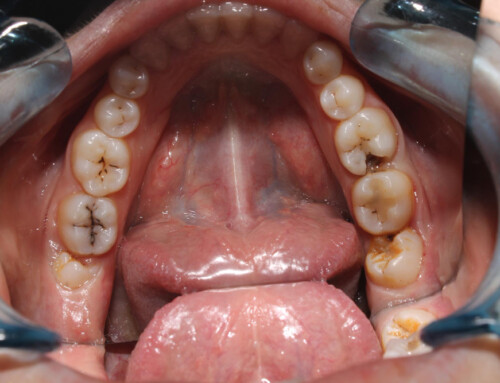Losing a dental crown can be both surprising and concerning, leaving you with questions about proper care until you can see your dentist. That exposed tooth now lacks its protective covering, making it vulnerable to sensitivity, damage, and potential infection.
Whether your crown fell out while eating, flossing, or seemingly out of nowhere, knowing how to handle this common dental emergency will help protect your tooth and reduce discomfort until professional treatment.
What to Do First When Your Crown Falls Off
When your crown falls off, stay calm and find it quickly. Rinse it gently with warm water to remove any debris, but avoid hot water, which could damage it. Place the crown in a clean container or small bag to keep it safe until your dental appointment.
Temporary Solutions for Crown Protection
Your exposed tooth needs protection while you wait. Temporary dental cement from your pharmacy works best—just follow the package directions. If you can’t find cement, dental wax, or even a small piece of sugar-free gum (not the sticky kind) can cover the exposed area. Continue brushing around the area gently, and consider using sensitive toothpaste if you’re experiencing discomfort.
When to Contact Your Emergency Dentist
Call your dentist right away if you’re in significant pain or if there are sharp edges bothering your cheek or tongue. Most dental offices reserve slots for emergencies, so don’t hesitate to call even after hours. While some can wait a day or two with a missing crown, waiting too long risks further damage. When you call, describe what happened, your pain level, and mention that you’ve saved the crown.
Can You Brush Your Teeth After Losing a Crown?
Yes, you should continue brushing after losing a crown, but with extra care. Use a soft-bristled toothbrush and gentle, circular motions around the exposed tooth. Avoid aggressive back-and-forth scrubbing that might damage the vulnerable area. Consider brushing the affected area at a 45-degree angle to clean the gumline without putting pressure directly on the exposed tooth.
Stick with fluoride toothpaste for regular cleaning, but consider switching to sensitive toothpaste for the affected area. Avoid whitening toothpaste or products with abrasive ingredients that could irritate the exposed tooth. Skip electric toothbrushes temporarily around the area where your crown fell off. Alcohol-based mouthwashes might cause discomfort, so opt for alcohol-free alternatives or a gentle saltwater rinse instead.
Exposed dentin under your missing crown can cause temperature sensitivity and discomfort. Try lukewarm water for rinsing rather than hot or cold. Breathe through your nose rather than your mouth to prevent air sensitivity. Consider taking over-the-counter pain relievers if discomfort persists, but remember these are temporary solutions until you can see your dentist. Keep the exposed area clean to prevent infection, but don’t overbrush, as this can worsen sensitivity.
Foods to Avoid with a Missing Crown
When your crown falls off, what you eat can make a big difference in preventing further damage. These foods should even be avoided with a dental crown, but certainly with an exposed tooth.
Sticky Foods
Caramels, gummy candies, and taffy can pull at temporary dental cement or even dislodge a loose crown you’ve temporarily reseated. These sticky treats can also get trapped in the exposed tooth, potentially causing tooth decay in this vulnerable area.
Hard Foods
Nuts, hard candies, and ice can crack the exposed tooth beneath your lost crown. Without its protective covering, your tooth is much more fragile and susceptible to fractures that could complicate your treatment.
Crunchy Foods
Potato chips, popcorn, and crisp vegetables put uneven pressure on your tooth. Small particles from these foods can also become lodged in the exposed area, increasing irritation and infection risk.
Very Hot or Cold Foods
Ice cream, hot coffee, or soup can trigger intense pain since the exposed dentin is highly sensitive to temperature changes. This sensitivity occurs because the dentin contains tiny fluid-filled tubules connected to the nerve.
Acidic Foods and Drinks
Citrus fruits, tomato-based foods, and sodas can cause significant discomfort and potentially damage the exposed tooth structure. Acids wear away at tooth enamel and can be particularly harsh on unprotected dentin.
Chewy Foods
Tough meats, bagels, and crusty breads require significant chewing force that can put stress on the vulnerable, natural tooth. This repeated pressure might damage the exposed tooth structure or cause pain in the nerve.
Sugary Foods and Drinks
Candy, cookies, and sweet beverages feed the bacteria in your mouth. Without the crown’s protection, sugar can more easily reach the tooth’s interior, potentially causing rapid decay and complications.
When to Seek Emergency Dental Care
Severe, throbbing pain that doesn’t subside with over-the-counter pain relievers signals potential nerve exposure or infection. Significant swelling around the tooth or in your face, cheek, or gums indicates a possible infection that needs urgent treatment.
If you notice pus around the exposed tooth or experience a fever alongside dental pain, these are signs of infection requiring immediate care. Excessive bleeding that doesn’t stop with gentle pressure also warrants emergency attention. Difficulty breathing or swallowing alongside dental issues is always a medical emergency.
Difference Between Urgent and Non-Urgent Crown Issues
Urgent crown issues include severe pain, significant infection signs, trauma that’s damaged both the crown and underlying tooth, or cases where the exposed tooth has sharp edges causing oral injuries. Non-urgent situations typically involve a crown that’s come off but causes minimal discomfort, no bleeding, and where the underlying tooth appears intact. While non-urgent cases still require prompt attention (within a few days), they don’t necessarily need same-day emergency care.
Options for After-Hours Dental Treatment
Most dental practices offer emergency phone lines with on-call dentists who can provide guidance until you can be seen. Many cities have dedicated emergency dental clinics that operate during evenings and weekends, specifically for urgent cases. Dental schools sometimes offer emergency services at reduced rates. Hospital emergency departments can help with severe infections or pain management until dental care is available. Some dentists also partner with teledentistry services to provide video consultations for after-hours guidance on managing your situation until you can get in-person care.
Your Path to Dental Recovery After Crown Loss
Your dental crown may be temporary, but your smile is permanent. Remember to contact your dentist immediately when a dental crown falls off, maintain gentle and good oral hygiene, and avoid foods that could cause further damage. With proper care and prompt professional attention, you’ll be back to confident smiling and comfortable chewing in no time




